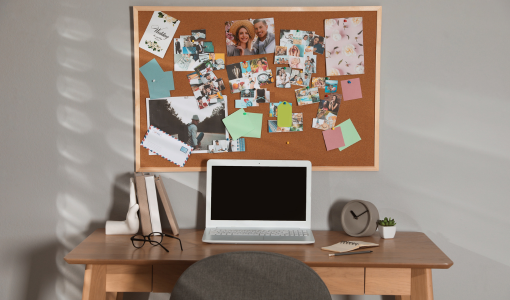The power of visualisation for leaders

01 August 2024
By Cherie Mylordis
When you think about visualisation, you might picture elite Olympian athletes imagining their historic victory or perfect 10 performance.
But visualisation is just as powerful in the business world as it is on the sports field or stage.
Visualisation helps leaders turn their thoughts and ideas into actionable steps that lead to success.
As a leadership coach, I’ve seen firsthand the transformative power of visualisation.
In fact, I’ve discovered that visualisation has such a strong power for leaders that it’s become a regular tool in my belt to guide them to achieve their goals.
'I’d then visualize making the national team, imagining it like a movie.'
Simone Biles, Olympic gymnast
So, what is visualisation?
Visualisation means picturing achieving your goals in your mind.
It helps you focus on what truly matters and what steps you need to take.
The idea behind visualisation is simply that thought precedes action.
But does visualisation work? Can we really imagine our successes into existence?
Short answer: yes.
Visualisation is backed by science
While visualisation might’ve been seen as ‘woo-woo’ in the past, it’s now gained scientific credibility.
Functional MRI scans show that visualisation activates the same brain areas as actual physical performance. This highlights its potential to improve motivation, confidence, and performance.
For example, a study found that visualising playing the piano activated the same brain areas as physically playing it. Another study demonstrated that, for athletes, visualisation was almost as effective as physical practice.
'I always think about what I want to accomplish, and I mentally rehearse it.’
Michael Phelps, Olympic swimmer
Why visualisation is crucial for leaders
Visualisation helps leaders define a clear vision, overcome challenges, recognise achievements and lead with confidence.
By visualising success, you can shift your focus from today's pressure to long-term goals. This clear vision lets you strategically plan and act to bring your goals closer to reality.
In my coaching practice, I often find female leaders holding themselves back due to self-doubt or fear. I guide them through a visualisation exercise where they see their future selves as wise mentors to those around them.
This helps leaders gain clarity and purpose, giving them a map to navigate daily pressures while moving close to their goals.
Imagining a point in time when you’ve achieved your vision helps reframe your thinking. It can lift you out of overwhelm and boost your motivation.
This mental exercise transforms strategic planning with a renewed sense of purpose, clarity and direction.
Tip: For more tips on how women can speak up, create and lead, I highly recommend Playing Big by Tara Mohr. It’s a book that can change your life, and I gift it to all the women I coach.
A quick visualisation exercise you can do right now
Pause and take five minutes for a short visualisation exercise:
- Close your eyes and relax. Imagine where you'd like to be in 12 months. What have you achieved? How does it feel? Who are you with? What are you saying to them? Make this future success as real and as vivid as possible in your mind. Feel the satisfaction of a job well done.
- Next, visualise yourself three months ahead from today. What steps have you taken to move closer towards your year-end goals?
- Finally, break it down further to the end of the month ahead and then the following month. What do you need to achieve this month to stay on track with your quarterly objectives?
How to incorporate visualisation into your daily routine
To maximise the power of visualisation, you can incorporate it into your daily routine with these tips:
- Schedule daily visualisation: Spend a few minutes each day visualising your goals and the steps to achieve them. You could do this while in the shower, brushing your teeth, drinking your morning coffee, or walking your dog. Regularly visualising your goals helps create new habits and shifts your mindset, making you believe in your ability to achieve them.
- Create a vision board: Make a visual representation of your goals and display it prominently. You can use a dedicated board or scrapbook by your desk. or create a virtual vision board using tools like Canva or Venngage.
- Prioritise coaching and accountability: Engage a coach, mentor or accountability buddy to share and refine your visualisation goals. They can provide support and encouragement, especially when you feel stuck.

How to avoid self-sabotage?
It's normal to encounter scepticism or difficulties when starting with visualisation, especially if you’ve never done it before.
You might feel silly or struggle to see your success clearly.
Or you might fall into the busy trap, thinking you're too busy with today's tasks to visualise tomorrow.
Acknowledge these feelings, accept them as part of trying something new, and persist.
Like learning to ride a bike, start with small steps, note your progress, and gradually build confidence.
Remember, visualisation is a proven technique that can be learned and improved with practice, so stick with it.
Ready to take your leadership to the next level?
For personalised support and guidance on mastering visualisation techniques, explore my leadership coaching packages. Or book a free 15-minute consultation, and we can discuss your needs.
As a leader, you have the potential to shape your own future and make a positive impact on those around you.
Visualisation is the key to unlocking this potential, helping you lead with confidence and clarity.
How will you incorporate visualisation into your leadership practice starting today?
Enter your email address and name to subscribe to our blog and receive notifications of new posts by email.

